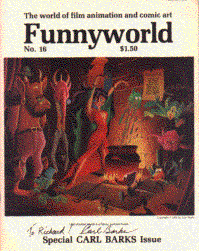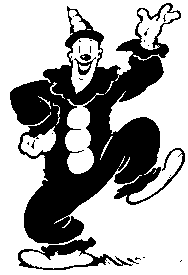|



              
 |
Working
for the Fleischers (continued)
An
Interview with Dick Huemer by
Joe Adamson
(page
3 of 3 pages)
Adamson:
Did this affect you very
seriously?
Huemer:
Not personally, no. I didn't
own any stock.
I didn't understand it.
Who did? The
animation industry
looked awfully
bad at that time too. Dls-
ney, of
course, had already entered the
field, and had
done some Oswalds.
They were far
superior to anything
anybody had
done, in my estimation.
And we -- me,
Harrison and Gould -
used to go
seek them out, find out
where they
were running and study
them. And, bad
as they look today -
and I've seen
them recently, and they
are pretty bad
-- they were tremen-
dously
superior to our things. That was
our opinion as
craftsmen of the busi-
ness. I was
with Fleischer again when
sound broke on
the scene; and the
Skeleton Dance
took New York by
storm, and
naturally everything went to
sound.
Adamson:
You didn't stay with the
Fleischers
long after sound came in.
Huemer:
Well, I was in and out of
Fleischer's
several times. I left to go into
the Associated
Animators. Then I came
back again.
Then I left to do my comic
strip. Then I
came back once more. And
then I left to
go with Charlie Mintz. The
last time I
left Max said, "All right now,
this is the
last time you're gonna leave!"
He didn't
really mean it. He was a
lovely guy. I
loved Max. He said,
"That's a
fine thing, leaving me ... but
this is the
last time you're gonna do it to
me." Ben
Sharpsteen had been touting
me to Walt
Disney. (There were only
about 50 of us
animators in the world,
you know, and
I was one of them.) And
when Walt
Disney came to New York
on a business
trip he looked me up with
the idea of me
coming to work for him. I
invited him to
dinner. He didn't know
New York, and
so I took him to a place
called The
Chili Villa, which even to
this day I
think served the finest Mex-
ican food I've
ever eaten. Simply mag-
nificent. I
took Walt and his wife Lily
there to talk
things over. It was under-
stood right
away that I would consider
working for
him, even before we went
to dinner. But
I wasn't absolutely sure.
He said,
"Yes, let's talk anyway." So we
went to Chili
Villa on 45th Street. And
all through
the meal I don't think Walt
addressed five
words to me. He sat and
brooded, and
ate this heavenly food,
and never said
anything about how
great it was,
or much of anything else.
So I spoke
mostly to his wife. And I
thought,
"This is certainly a strange
guy. I mean
nobody has ever done this
to me in my
life." Well, later I found out
that he was in
very deep financial trou-
ble, and was
brooding. He had some
serious
setback. Something about the
business end
of his studio, I think. Ob-
viously,
that's why he'd come to New
York. So that
was my weird introduc-
tion to Walt
Disney. I finally agreed to
work for him,
but a day later I got a bet-
ter offer from
Mintz and decided to take
that. When I
called Walt up and told
him, there was
silence for a while.
Finally he
said, "Well, okay, but you'll
be very
sorry." And I was. Because I
should have
gone with him right then
and there. I
would have had a better
time, and I'd
have enjoyed working in
the business
with a real genius.
Although I
must say the money he
offered wasn't
nearly comparable to
what Mintz was
going to pay me.
We did
Scrappy and Toby the Pup for
Mintz. The
first series we did was Toby
the Pup. Sort
of a nondescript character.
A little black
beast, that walked on its
hind legs, and
had a big mop of black
hair. A weird
dog-like thing with long
ears. I don't
believe there are any of
these still in existence.
Adamson:
Was he sympathetic?
Who created him?
Huemer:
Sid Marcus created him. He
and I came out
to start the series. We
had left
Fleischer's together. And when
Mintz moved
his New York operation
to Caliiornia,
we went along with him,
and started
Toby the Pup. Mintz also
brought
Harrison and Gould out here to
continue Krazy
Kat, which they had
been doing.
Both series ran concur-
rently.
Sid
Marcus and I directed and did our
own stories.
But we also had to animate
at the same
time. Once we'd roughly
laid the
picture out, and timed it, why,
there wasn't
much else but to animate
it. After all,
we were still our best
animators,
certainly better than any
neophytes we
could then hire. Harrison
and Gould did
the same. They animated
most of their
Krazy Kats.
Adamson:
Did you have pre-
recorded sound?
Huemer: Yes, occasionally.
Adamson:
So, you were pretty
sophisticated
by this time.
Huemer:
Yes, technically we were
comparable to
all the other studios.
After I left
Mintz, they went on for
many years
doing Krazy Kat and
Scrappy
mostly. So my leaving didn't
ruin them.
Adamson: What did you think of
what you
turned out at this time?
Huemer:
Not much. Some of the
Scrappys were
all right. But they didn't
compare to
Disney's cartoons. Let's put
it that way.
I went
with Mintz in 1930, and stayed
until 1933.
When Mintz tried to pare our
salaries
during the Depression we
decided to
strike. And so I left Mintz.
But instead of
going on strike, I went
over to
Disney's at last. I had greatly
regretted
turning him down, as he had
predicted.
Adamson:
Was there much
difference in salary?
Huemer:
There was quite a come-
down in salary
for me -- almost half.
Walt was not
one for paying big salaries
at that time.
I'm sure he would have but
he couldn't
afford it.
Adamson:
Mintz was?
Huemer:
Mintz was, simply because I
had the
reputation of being one of the
experienced
men he would need to start
a new project.
He underpaid the rest of
the staff as
did everybody else, in those
pre-union days.
Adamson:
What was it like, working
for Mintz?
Huemer:
In some ways very agree-
able. Sid and
I as well as Harrison and
Gould had
complete freedom to ani-
mate whatever
ideas came to us. You
see, there
were two kinds of producers
in our
business. There were the guys
who had come
up from the animation
board and were
therefore completely
creative in a
technical sense. Men like
Disney, and
the Fleischers, and Terry,
and so forth.
And then there were the
businessmen
and promoters who were
conversant
with the infighting tactics of
the motion
picture jungle. Men who
knew how to
wangle releases and take
care of the
headaches that more crea-
tive people
find so hard to deal with.
Mintz was such
a promoter, and a
damned
competent one. So as long as
we delivered
on time and appeared to
be doing a
good job he left us pretty
much alone. So
I must say that besides
the fact that
I secretly kind of longed to
go with
Disney, my years with Charlie
Mintz—if
not artistically a triumph—
were at least
pleasant. [END]
|
 |
From Funnyworld, No. 16, Winter 1974-75.
© 1975 by J. Michael Barrier, by whose permission this article
is reprinted. Read Mike's new book, Hollywood
Cartoons, Oxford University Press, New York, 1999.
|
|


![]()
![]()
![]()
![]()
![]()
![]()
![]()
![]()
![]()
![]()
![]()
![]()
![]()
![]()
![]()
![]()
![]()
